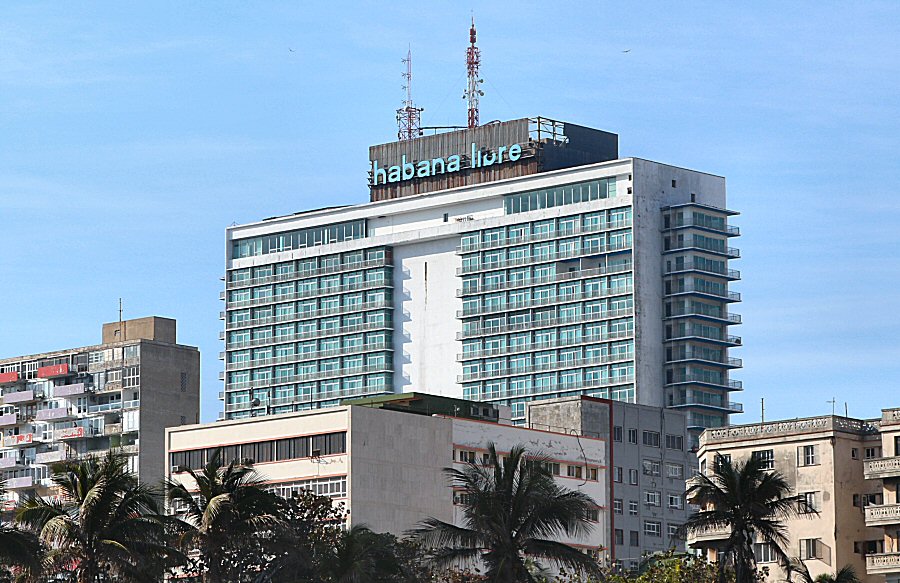
The five-star Habana Libre Hotel
that is located on a hillside at the boundary of Central
Havana and the Vedado district. It is one of the most
majestic buildings in Havana that can be seen from nearly
all of western part of Havana. It was the tallest hotel of
the hotels chain of Hilton International in the period, when
it served under the name Hotel Hilton Habana.
HISTORY
In the 1920s, the prohibition of
the production, sale and consumption of alcoholic beverages
in the US caused thousands of Americans to flock to Cuba,
leading to a boom in hotel operations in the island. In the
same way, the growing popularity of gambling and sex trade
in Cuba during the time of the presidency of Fulgencio
Batista led to an increasing flow of foreigners. Thus, the
lodging industry that Fulgencio Batista also had a direct
share, became a profitable industry in Cuba, particularly in
the capital. In this context, in the early 1950s, it was
decided to build a new hotel with large capacity to meet the
need for accommodation in the capital. According to the
project, carried out under the personal auspices of
President Fulgencio Batista, the Caja de Retiro y Asistencia
Social de los Trabajadores Gastronomicos (Retirement and
Social Assistance Fund for Gastronomic Workers) purchased
the land, bordered by the streets L, M, 23 and 25 in Vedado
district as a profitable investment in 1953. It was argued
that the establishment would generate a lot of money for the
pensions of the workers, when it would start to operate
according the management contract that would be signed by
the Fund and the Hilton Hotels International. In fact, the
regime used the fund to defray the expenses of the Hilton
Hotels International, without taking into account the
thoughts of the employees of that sector. The necessary
funding for the construction was provided by Banco de
Fomento Agricola e Industrial de Cuba. On that date, it was
estimated that the construction of such a hotel would cost 7
million dollars; however, two years later the estimated cost
raised to its three-fold, and the building could be
completed at a cost of 24 million dollars. In the same year,
a contract was signed with the American Hilton Hotels
International to operate the hotel and the contract was
approved by the Court of Auditors in 1954. La Rampa that was
the action canter of the gambling and prostitution of the
1940s and 1950s, was chosen particularly as the place of the
new hotel.
The building was designed by the
prestigious firm Welton Becket & Associates from Los
Angeles. The architect Welton Becket had previously designed
the Beverly Hilton. He worked together with the Cuban
architects Lin Arroyo, the Minister of Public Works, and
Gabriela Menéndez. The hotel was constructed by the
Frederick Snare Corporation.
During the four-years construction
period, more than two thousand construction workers were
inevitably affected by the political situation and the
suffocating economic crisis in the country. Batista’s rule
that became more bloody every day due to the impending
revolution, has turned to some workers working in the
construction of the hotel, so that some have been tortured,
whereas some have been killed, but in every action against
the government the construction workers acted together with
the rebels. On the other hand, the insufficiency in the
security and protection facilities led to multiple cases of
accidents, causing even deaths. However, the construction
area was enclosed with the most luxurious fence in Havana.
When the construction was
completed, the opening of the hotel was announced to public
by publishing huge advertisements in the newspapers. The
Hotel Habana Hilton was inaugurated with a ceremony in 1958
that was remembered for months. Martha Fernández de Batista,
the wife of the President, Conrad Hilton and dozens of
well-known personalities, Hollywood artists and American
journalists that arrived in Havana by a direct flight from
the US that night, attended the opening ceremony. The
opening festivities lasted for five days. In the short
period before the Revolution the hotel was administered by
Conrad Hilton’s son in law José A. Menéndez.
The new hotel had many facilities:
an elegant casino, six restaurants and bars, including a
Trader Vic’s, an outdoor pool surrounded by cabanas, shops
and a closed car parking.
The casino was leased for 1 million dollars a year to a group, consisting of Roberto Mendoza, the wealthy sugar baron and business associate of Batista, Sidney Orseck, an attorney from New York and Kenneth F. Johnson, the Nevada senator. The casino was in the scope of several groups that wanted to lease it. Several groups were rejected because they had either underworld connections, or they did not want to undergo the rigid investigation. When Albert Anastasia, the boss of the Gambino crime family, was murdered while sitting in a barber chair at the Park Sheraton Hotel in Manhattan, the police suspected of Roberto Mendoza of being instigator of the murder, as he and Anastasia had substantial interests in gambling in Havana and Mendoza was in New York at the time of the assassination. In fact, Anastasia’s underboss Carlo Gambini that was in partnership with famous Meyer Lansky, the accountant of Mafia, in controlling the gambling in Cuba, was the prime suspect, as he might have organize the assassination to take over the family, but the murder was never solved officially.

